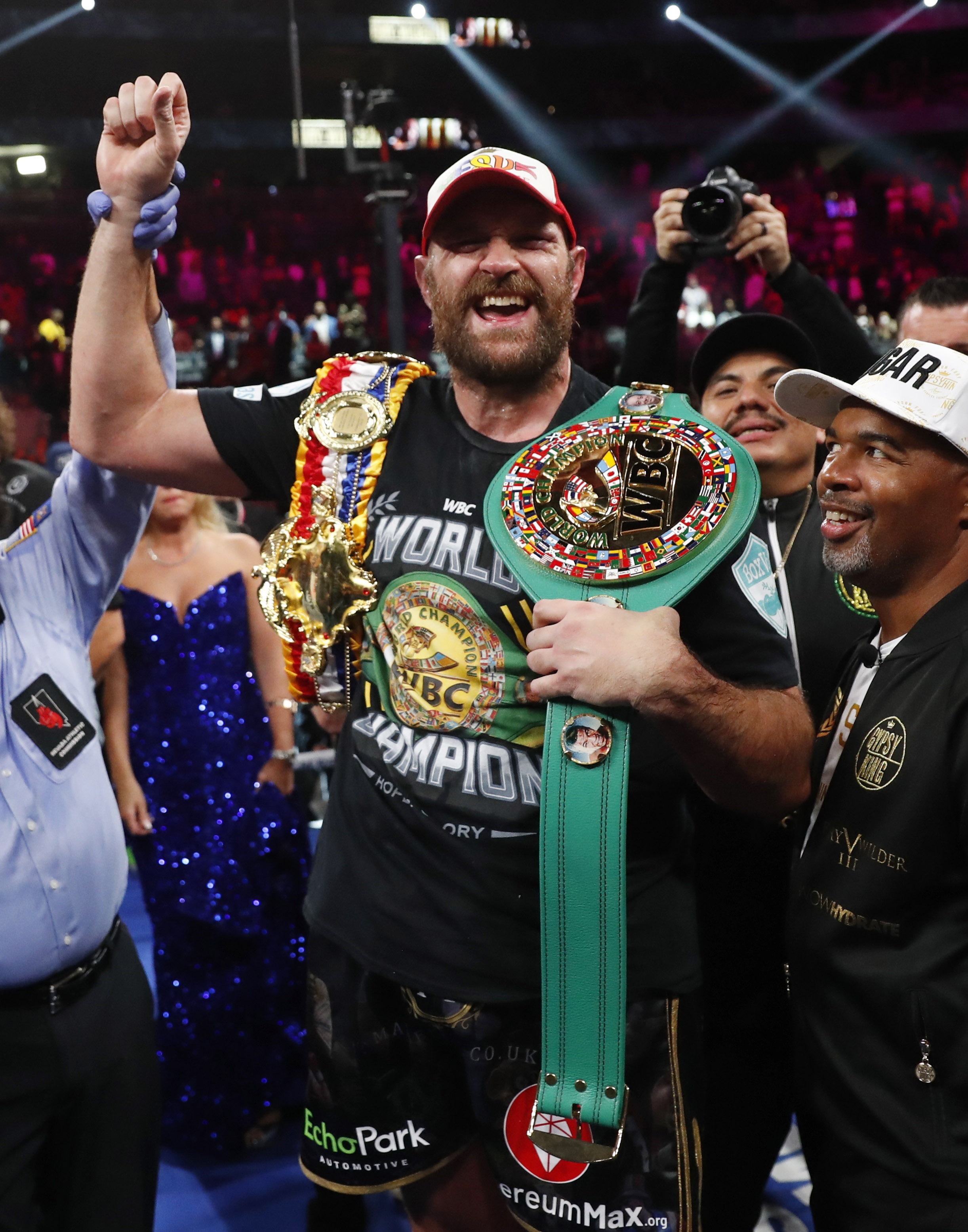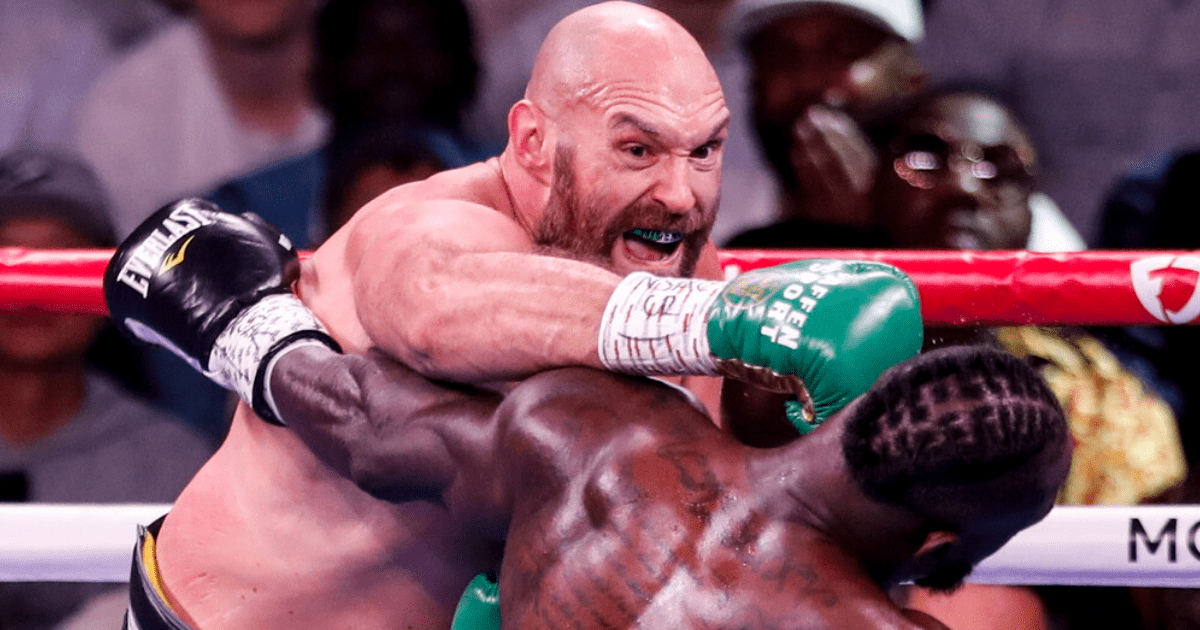TYSON FURY has revealed the devastating impact of ex-rival Deontay Wilder’s punches.
The Gypsy King, 34, met the Bronze Bomber, 36, in a trilogy.
Fury experienced short-term memory loss after his third fight with Wilder
The Brit was knocked down multiple times before rising up to secure two wins and a draw
 The boxer’s new autobiography Gloves Off, is out on November 10
The boxer’s new autobiography Gloves Off, is out on November 10
Los Angeles played host to the first fight in 2018, which ended in a split draw, despite the thrilling contest which saw Fury rise from the ashes like The Undertaker late on in Round 12.
The pair then fought again in 2019 and Fury defeated Wilder via technical knockout, picking up the WBC heavyweight title.
A trilogy fight was then held in 2021, with both fighters landing heavy shots.
Both scored knockdowns but Fury retained his title with a knockout.
However, Fury experienced some side effects to his gruelling fights with boxing‘s most devastating puncher.
Fury experienced short-term memory loss and his head was covered in “tennis ball-sized lumps”.
In an extract from his autobiography, Gloves Off, Fury recalled: “So while getting my face punched in for a living has put millions of pounds in the bank, a fighter needs to know when their time is up — and mine is near.
“Walking away from boxing may be the hardest thing I ever do.
“All I know is that I don’t want to overstay my welcome, ruin my legacy, or die from a big right to the side of the head.
“And believe me, an ending like that has felt worryingly real at times.
“I even experienced short-term memory loss following that bruising encounter with Wilder in 2021, when, in the hours after the win, my head covered in tennis ball-sized lumps, it was impossible to remember how many times I’d gone down.
“Everything was foggy, and the experience frightened me.
“No way do I want to end up living out my days in a wheelchair, or eating my dinners through a straw.
“After that fight with Wilder, I told my promoter Frank Warren that I planned to retire.”
Despite the evident shock to Fury’s system, he fought again earlier this year against fellow Brit Dillian Whyte.
Fury retained his WBC title inside a packed-out Wembley Stadium, finishing off with another KO.
He will fight again at the end of this year, facing off against Derek Chisora in a trilogy fight, and could even go further and take on Oleksandr Usyk in a unification fight for the ages.

Fury says it won’t be long before he retires from boxing

Walking away from boxing is the hardest thing he will have to do, says Fury
Frequently Asked Questions
How to defend yourself:
Protect your head when you are being attacked. Avoid getting punched. You must know how to stop an incoming punch. Here are the steps:
- Be tall and square your shoulders.
- Keep your elbows straight up.
- Your forearm can block the punch coming from your opponent.
- Counterattack immediately.
- Continue blocking until you see the attacker run away.
- Don’t give up on your defense.
How can I box without a partner?
If you’re looking for a partner to practice boxing, you can watch boxing matches on television. Or you can find an amateur boxing club near you. Regular training sessions are a common feature of amateur boxing clubs. These sessions often involve sparring partners who hit the pads together.
You can also use punching bags to practice boxing. Before you use the bag, be sure to protect yourself with gloves or boxing gloves.
What can I do to improve my punching?
Boxing is all in the form of punching. If you want to be a better boxer, you must master punch technique. Here are some tips for improving your punching ability.
- Keep your head straight. When you are throwing punches, your head should be raised.
- Punch from the shoulder. Try to punch from the shoulder, not the chin when you throw a punch.
- Concentrate on your feet. Avoid moving your feet while you punch.
- Use short punches that are quick. You will feel tired quicker if you throw longer punches.
- Don’t forget about defense! Always block any incoming punches.
- Use your elbows. To defend yourself, your elbows are a good option.
- Learn to use your legs. Properly using your legs will help you avoid being knocked down.
- Keep practicing every day. Even though you may feel tired after training, keep going. To be a good coach, you need to practice.
- Have fun Enjoy what your doing.
- Breathe. You will be stronger and have more energy if you breathe correctly.
- Relax. Don’t worry so much about making mistakes. Learn new things instead of worrying about making mistakes.
- Be patient. Boxing is hard. It takes time for you to get better at boxing.
- Never stop improving. As long as there’s room to improve, there’ll be more.
- You can listen to music. You can relax and focus during training by listening to music.
- View videos of professional fighters. You can be inspired by watching them fight.
- Read books. Reading helps you better understand boxing techniques.
- Pause. Sometimes it helps to take a break from boxing. Go outside to play soccer or basketball.
- Find a coach. Coaching can make you more efficient at boxing.
- Do push-ups. Push-ups are great for building strength and endurance.
What does it take to become professional boxer?
To become a professional boxer, it takes dedication and years of hard work. If you want to become a professional boxer, you’ll need to dedicate at least 10 hours per week to training.
How can I improve my defense in fighting?
You can improve your defense in fighting by learning how to fight smart. You need to be able to defend yourself from all angles and counterattack if necessary.
If you don’t know how fight, you won’t be ready for anything. You’ll just get beaten up. If you know how to fight you will be ready for anything.
Here are some ways to improve your defense.
- Know where your opponent’s attack is coming from. This means that you need to pay close attention and observe your opponent’s body language. If your opponent appears nervous, it could mean that he’s about to attack again.
- Keep your cool. Don’t panic. Instead, be calm and focussed.
- Block with your arms. You can defend yourself against attacks by blocking with your arms.
- Counterattack. If you see your opponent attacking you, then you need to counterattack immediately.
- Fight dirty. Fighting dirty is another method to defend yourself. You can kick your opponent back if he throws a kick at it.
Statistics
- It is just like normal sparring with a partner, but you want to throw punches at 75% of your normal speed. (wikihow.com)
- This article received 39 testimonials and 89% of readers who voted found it helpful, earning it our reader-approved status. (wikihow.com)
External Links
expertboxing.com
boxandflow.com
How To
Here are the Basic Skills of Boxing
How to box effectively
Boxing is the most loved sport in the world. It is made up of two competitors who aim to knock the head off each other. There are different rules for boxing, and they vary from one country to the next. There are generally three types of boxing: Amateur, Professional, and Olympic.
Amateur boxing is usually practiced at school, college or university. This type of boxing allows sparring without protection. Usually amateur boxing competitions consist of three rounds of five minutes each. There are many styles of amateur boxing such as Kickboxing or Muay Thai, Taekwondo and Karate, Judo and Wrestling, among others.
Most professional boxing takes place in gyms, clubs, and stadiums. They use protective equipment, such as mouthpieces, nose guards, shin protectors, elbow pads knee pads, waist belts and groin protectors. Professional boxing competitions consist of six rounds lasting four minutes each. There are several different styles of professional boxing including Boxing, MMA (Mixed Martial Arts), Kickboxing, Muay Thai, Taekwondo and others.
Olympic boxing is practiced at the Olympics. Boxers are required to wear international standards-compliant protective gear. The competition lasts for eight rounds, each lasting three minutes. Olympic boxing is limited to two styles: Light Flyweight and Heavyweight.
Boxing is based on the following skills:
- Punching techniques
- Techniques for protecting yourself
- Footwork
- Stance
- The body moves
- Defense
- Combination
- Rotation
- Sparring
Punching Techniques
There are seven types: Left Hook (right hook), Right Hook (uppercut), Cross (cross), Straight, Overhand, Underhand. Each punch is different. Some punches require greater strength than others. A strong uppercut for example requires a lot of force. A straight punch, on the other hand requires less power and is quicker than other punches.
There are many combinations of punches. These are combinations of punches which work together to achieve a goal. An entire combination could have several parts. A combination may include multiple parts. For example, damage to the jaw of an opponent can be caused by a left hook and a right cross.
Guard Techniques
A boxer protects himself by using his body. He does this by using his legs, arms, elbows, hands, knees and feet.
Legs
Boxers should use their legs to defend against kicks. He raises his leg when he is hit with a kick and then moves away from the opponent. To avoid being kicked on his side, he will bend his knees if the attack is from the front. If the attack is from the side, he will bend his knees to avoid being kicked on the side.
Elbows
Because elbow strikes inflict a lot of pain, they are very effective. You can deliver an elbow strike directly or indirectly. Directly, you strike your opponent with your forearm. Indirectly, you hit him with another portion of your arm.
Hands
Boxers use their hands as a shield against incoming punches. Boxers raise their fists to block incoming blows and then move in the direction of the attacker’s attack. They then make contact with their attacker’s fist.
Knees
Boxers should bend their knees when receiving blows to the abdomen, stomach, or chest. Knee strikes are often used for defense purposes.
Feet
A boxer should not be afraid to respond to an attack. This will help him gain distance from his opponent. Also, boxers must maintain their balance while delivering counter-attacks.
Stances
In order to box effectively, a boxer needs to establish a stance. His stance determines how he defends himself. It dictates how he places his body and faces his opponent. There are many positions that boxers can adopt. These are some of our most favorite:
- Low stance
- High stance
- Southpaw stance
- Western stance
The Body Movement
Boxers must maneuver around their opponent to win fights. This involves changing positions, speed, rhythm and timing.
Rotation
Boxers rotate their arms when they throw a punch. You can rotate at different speeds depending upon the punch.
Combinations
The timing of each punch determines the effectiveness of a combination. A combination of strong and weak punches will produce a good result.
Spare parts
Sparring is an exercise session to improve boxing skills. Sparring is a training session that helps a boxer train his mind and body. In conclusion, the purpose of sparring is to learn how to fight and not get hurt.
In conclusion, learning to box requires dedication and patience. To become a better fighter, you have to train hard and continue to work.

